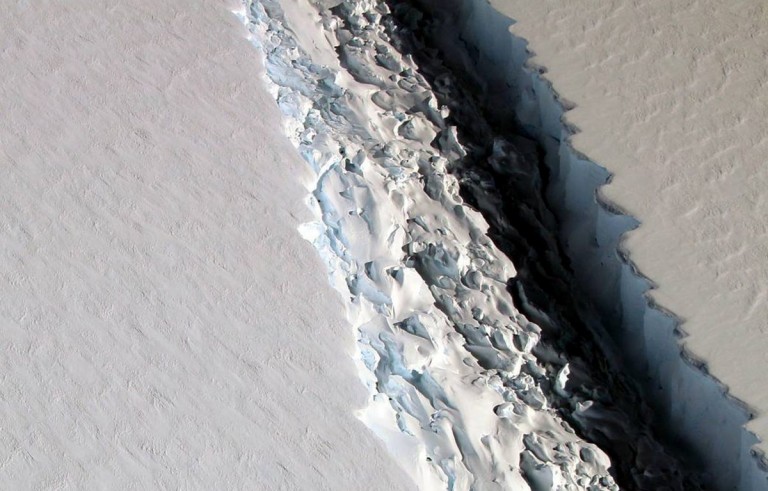HARI SREENIVASAN, PBS NEWSHOUR WEEKEND ANCHOR: Scientists are predicting a 110-mile sheet of ice — a chunk the size of the state of Delaware — will break off Antarctica in the coming days or weeks. The cause is warming ocean waters, and the ice melt has implications for sea level rise well beyond the South Pole region.
"The National Geographic" July issue cover story is called "Antarctica is Melting, and Giant Ice Cracks are Just the Start".
Joining me now from Birmingham, Alabama, to discuss this is Robert Kunzig, the senior environmental editor for "National Geographic."
Thanks for joining us.
First of all, a chunk of ice the size of Delaware seems almost impossible to, you know, put our heads around, but that's actually a small piece when you think of the size of Antarctica.
ROBERT KUNZIG, SENIOR ENVIRONMENTAL EDITOR, NATIONAL GEOGRAPHIC: Yes, it is, and it's even just a small piece, Hari, of the Larsen C Ice Shelf that it's breaking off of. Larsen C is a floating slab of ice size that's the size of Vermont and New Hampshire combined.
And what's happening there is that a rift that has been growing for years now, this year really accelerated. As you said, it's about 15 miles wide, it — and it's been growing from south to north, basically going to slice a big chunk of ice off the ice shelf and that chunk will be the size of Delaware.
SREENIVASAN: You know, we have a picture of one of the cracks that are going through. Scientists have been looking and studying and trying to get at some of these cracks for a long time. How deep does it go down and why are they so concerned?
KUNZIG: The crack in Larsen C where Larson C meets the sea, it's about 600 feet thick. And most of that is under water. So, there's an ice cliff of about 60 feet that towers above the waves. So, the crack goes about, at least 600 feet.
If this iceberg goes, the worry is that the whole ice shelf might collapse as other ice shelves on the Antarctic Peninsula have already collapsed. And ice shelves there and elsewhere around Antarctica are really kind of the canaries in the coal mine that they're a sign of what's happening all over, which is that Antarctica is melting faster than scientists had expected.

SREENIVASAN: So, this isn't just about the fact that the water is already in the water and it's just melting in a glass of water, say. We're actually adding new ice cubes to that glass, which is what makes, what, the sea level rise?
KUNZIG: Well, yes. That's the perfect analogy. This ice, the Larsen C Ice Shelf is floating. It is like an ice cube in a glass of water. So, even if all of it collapses, that, itself, does not add to sea level.
But the thing about ice shelves is that they function like corks. They're bottling up a much larger amount ice that's on the ground, on the land in this case behind them. And when — that's the glaciers that are carrying ice from the interior of Antarctica towards the sea. The ice shelves are really just sort of the floating ends of the glaciers. And so, when that flow increases, more ice is falling into the sea and raising sea level.
SREENIVASAN: In the article, it talks about how scientists measure what's happening kind of under water. What's happening underneath these ice sheets? How is there warmer water and what's the interaction of salt water do to this all?
KUNZIG: Well, the big thing that's been happening in recent years is that warmer ocean water, and when I say warm, warmer, I don't mean really warm. We're talking about four, five degrees above freezing. That water is penetrating further up towards the coast of Antarctica under the ice shelf and it is undermining the ice shelves. It's melting them and thinning them from below and weakening them.
SREENIVASAN: You know, you have a large map that you have in "The National Geographic" article that kind of puts this in perspective and there's areas of kind of purple that are the areas that are kind of floating off. And there's a couple of patches of red, where it's really happening at an incredible rate.
Tell us about how fast it's happening in, say, the Pine Glacier.
KUNZIG: Basically, it's been an acceleration by several times. All over Antarctica, the loss of ice from the floating ice shelves has increased by a factor of 12 in the past two decades. So where in the mid ‘90s, they were losing six billion tons of ice. Now, they are losing 74.
What it is, it's natural for these glaciers to float in the sea. But what's happening is the speed has increased.
SREENIVASAN: Robert Kunzig, the senior environment editor for "National Geographic", thanks so much for joining us.
KUNZIG: Thank you, Hari.











